Altitude and Temperature Drive Spatial and Temporal Changes in Vegetation Cover on the Eastern Tibetan Plateau
Abstract
1. Introduction
2. Materials and Methods
2.1. Study Area
2.2. FVC Calculation
2.3. Environmental Factors
2.4. Data Analysis
2.4.1. Trend Analysis
2.4.2. Factor Analysis
2.4.3. Correlation Analysis
3. Results
3.1. Characteristics of FVC Change
3.2. Characteristics of Climate Change
3.3. Drivers of FVC Change
3.3.1. Factor Explanatory Power
3.3.2. Impact of Altitude on FVC Change
3.3.3. Impact of Temperature on FVC Change
4. Discussion
5. Conclusions
Author Contributions
Funding
Data Availability Statement
Acknowledgments
Conflicts of Interest
References
- Cheng, Y.; He, G.; Luo, J.; Gu, H. Effects of Climate Change on Temperature Sensitivity of Vegetation Growth in Huang-Huai-Hai Plain: Spatial–Temporal Dynamics and Ecological Adaptability. Remote Sens. 2024, 16, 4024. [Google Scholar] [CrossRef]
- Zhang, H.; Chang, J.; Zhang, L.; Wang, Y.; Li, Y.; Wang, X. NDVI dynamic changes and their relationship with meteorological factors and soil moisture. Environ. Earth Sci. 2018, 77, 582. [Google Scholar] [CrossRef]
- Hester, A.J.; Britton, A.J.; Hewison, R.L.; Ross, L.C.; Potts, J.M. Long-term vegetation change in Scotland’s native forests. Biol. Conserv. 2019, 235, 136–146. [Google Scholar] [CrossRef]
- Braghiere, R.K.; Quaife, T.; Black, E.; He, L.; Chen, J.M. Underestimation of Global Photosynthesis in Earth System Models Due to Representation of Vegetation Structure. Glob. Biogeochem. Cycles 2019, 33, 1358–1369. [Google Scholar] [CrossRef]
- Fourcade, Y.; Besnard, A.G.; Beslot, E.; Hennique, S.; Mourgaud, G.; Berdin, G.; Secondi, J. Habitat selection in a dynamic seasonal environment: Vegetation composition drives the choice of the breeding habitat for the community of passerines in floodplain grasslands. Biol. Conserv. 2018, 228, 301–309. [Google Scholar] [CrossRef]
- García-Pardo, K.A.; Moreno-Rangel, D.; Domínguez-Amarillo, S.; García-Chávez, J.R. Remote sensing for the assessment of ecosystem services provided by urban vegetation: A review of the methods applied. Urban For. Urban Green 2022, 74, 127636. [Google Scholar] [CrossRef]
- Liu, W.; Mo, X.; Liu, S.; Lu, C. Impacts of climate change on grassland fractional vegetation cover variation on the Tibetan Plateau. Sci. Total Environ. 2024, 939, 173320. [Google Scholar] [CrossRef]
- Zhang, Y.; Zhang, L.; Wang, J.; Dong, G.; Wei, Y. Quantitative analysis of NDVI driving factors based on the geographical detector model in the Chengdu-Chongqing region, China. Ecol. Indic. 2023, 155, 110978. [Google Scholar] [CrossRef]
- Zhang, H.; He, Z.; Xu, J.; Mu, W.; Chen, Y.; Wang, G. Analysis of Spatial and Temporal Changes in Vegetation Cover and Driving Forces in the Wuding River Basin, Loess Plateau. Forests 2023, 15, 82. [Google Scholar] [CrossRef]
- Jin, J.; Wang, Q.; Li, L. Long-term oscillation of drought conditions in the western China: An analysis of PDSI on a decadal scale. J. Arid Land 2016, 8, 819–831. [Google Scholar] [CrossRef]
- Lai, J.; Zhao, T.; Qi, S. Spatiotemporal Variation in Vegetation and Its Driving Mechanisms in the Southwest Alpine Canyon Area of China. Forests 2023, 14, 2357. [Google Scholar] [CrossRef]
- Qiu, T.; Sharma, S.; Woodall, C.W.; Clark, J.S. Niche Shifts from Trees to Fecundity to Recruitment That Determine Species Response to Climate Change. Front. Ecol. Evol. 2021, 9, 719141. [Google Scholar] [CrossRef]
- Shi, F.; Wu, X.; Li, X.; Chen, D.; Liu, H.; Liu, S.; Hu, X.; He, B.; Shi, C.; Wang, P.; et al. Weakening Relationship Between Vegetation Growth over the Tibetan Plateau and Large-Scale Climate Variability. J. Geophys. Res. Biogeosci. 2018, 123, 1247–1259. [Google Scholar] [CrossRef]
- Yuan, N.; Feng, Y.; Liang, S.; Wang, G.; Yin, T.; Yan, D.; Wu, P.; Kuang, X.; Wan, L. Spatial gathering characteristics of drought in the Qinghai-Tibet Plateau. Front. Environ. Sci. 2022, 10, 1008886. [Google Scholar] [CrossRef]
- Li, G.; Yu, Z.; Li, Y.; Li, Z.; Ju, Q.; Huang, Y. The evolution of precipitation and its physical mechanisms in arid and humid regions of the Tibetan Plateau. Atmos. Res. 2023, 285, 106638. [Google Scholar] [CrossRef]
- Meng, Y.; Duan, K.; Shi, P.; Shang, W.; Li, S.; Cheng, Y.; Xing, L.; Chen, R.; He, J. Sensitive temperature changes on the Tibetan Plateau in response to global warming. Atmos. Res. 2023, 294, 106948. [Google Scholar] [CrossRef]
- Zhang, Y.; Hu, Q.; Zou, F. Spatio-Temporal Changes of Vegetation Net Primary Productivity and Its Driving Factors on the Qinghai-Tibetan Plateau from 2001 to 2017. Remote Sens. 2021, 13, 1566. [Google Scholar] [CrossRef]
- Maharjan, S.K.; Sterck, F.J.; Raes, N.; Zhao, Y.; Poorter, L. Climate change induced elevational range shifts of Himalayan tree species. Biotropica 2023, 55, 53–69. [Google Scholar] [CrossRef]
- Afuye, G.A.; Kalumba, A.M.; Orimoloye, I.R. Characterisation of Vegetation Response to Climate Change: A Review. Sustainability 2021, 13, 7265. [Google Scholar] [CrossRef]
- Ontel, I.; Avram, S.; Gheorghe, C.A.; Niculae, M.I.; Pascu, I.S.; Rodino, S. Shifting vegetation phenology in protected areas: A response to climate change. Ecol. Inform. 2025, 85, 102962. [Google Scholar] [CrossRef]
- Ma, J.; Ren, H.-L.; Mao, X.; Liu, M.; Wang, T.; Ma, X. Spatiotemporal Evolution Disparities of Vegetation Trends over the Tibetan Plateau Under Climate Change. Remote Sens. 2024, 16, 2585. [Google Scholar] [CrossRef]
- Zarei, A.; Asadi, E.; Ebrahimi, A.; Jafari, M.; Malekian, A.; Mohammadi Nasrabadi, H.; Chemura, A.; Maskell, G. Prediction of future grassland vegetation cover fluctuation under climate change scenarios. Ecol. Indic. 2020, 119, 106858. [Google Scholar] [CrossRef]
- Zhong, F.; Xu, X.; Li, Z.; Zeng, X.; Yi, R.; Luo, W.; Zhang, Y.; Xu, C. Relationships between lithology, topography, soil, and vegetation, and their implications for karst vegetation restoration. CATENA 2022, 209, 105831. [Google Scholar] [CrossRef]
- Fan, J.; Xu, Y.; Ge, H.; Yang, W. Vegetation growth variation in relation to topography in Horqin Sandy Land. Ecol. Indic. 2020, 113, 106215. [Google Scholar] [CrossRef]
- Wang, B.; Cheng, W.; Xu, H.; Wang, R.; Song, K.; Bao, A.; Shi, Q. Vegetation differentiation characteristics and control mechanisms in the Altay region based on topographic gradients. Ecol. Indic. 2024, 160, 111838. [Google Scholar] [CrossRef]
- Li, Q.; Shi, X.; Wu, Q. Exploring suitable topographical factor conditions for vegetation growth in Wanhuigou catchment on the Loess Plateau, China: A new perspective for ecological protection and restoration. Ecol. Eng. 2020, 158, 106053. [Google Scholar] [CrossRef]
- Fan, Z.; Bai, X. Scenarios of potential vegetation distribution in the different gradient zones of Qinghai-Tibet Plateau under future climate change. Sci. Total Environ. 2021, 796, 148918. [Google Scholar] [CrossRef]
- Thakur, D.; Chawla, A. Functional diversity along elevational gradients in the high altitude vegetation of the western Himalaya. Biodivers. Conserv. 2019, 28, 1977–1996. [Google Scholar] [CrossRef]
- Bennie, J.; Hill, M.O.; Baxter, R.; Huntley, B. Influence of slope and aspect on long-term vegetation change in British chalk grasslands. J. Ecol. 2006, 94, 355–368. [Google Scholar] [CrossRef]
- Li, Y.; Gong, J.; Zhang, Y. Investigating the Relationship Between Topographic Factors and Vegetation Spatial Patterns in the Alpine Plateau: A Case Study in the Southwestern Tibetan Plateau. Remote Sens. 2023, 15, 5356. [Google Scholar] [CrossRef]
- Feng, Y.; Shi, S.; Niu, P.; Ye, P.; Wang, X.; Zhang, X. Climate and Altitude Drive Spatial and Temporal Changes in Forests on the Eastern Tibetan Plateau—Evidence from the Shaluli Mountain. Forests 2024, 15, 1968. [Google Scholar] [CrossRef]
- Xu, P.; Zhou, T.; Yi, C.; Fang, W.; Hendrey, G.; Zhao, X. Forest drought resistance distinguished by canopy height. Environ. Res. Lett. 2018, 13, 075003. [Google Scholar] [CrossRef]
- Anees, S.A.; Zhang, X.; Shakeel, M.; Al-Kahtani, M.A.; Khan, K.A.; Akram, M.; Ghramh, H.A. Estimation of fractional vegetation cover dynamics based on satellite remote sensing in Pakistan: A comprehensive study on the FVC and its drivers. J. King Saud. Univ. Sci. 2022, 34, 101848. [Google Scholar] [CrossRef]
- Melese, T.; Assefa, G.; Terefe, B.; Belay, T.; Bayable, G.; Senamew, A. Machine learning-based drought prediction using Palmer Drought Severity Index and TerraClimate data in Ethiopia. PLoS ONE 2025, 20, e0326174. [Google Scholar] [CrossRef] [PubMed]
- Abatzoglou, J.T.; Dobrowski, S.Z.; Parks, S.A.; Hegewisch, K.C. TerraClimate, a high-resolution global dataset of monthly climate and climatic water balance from 1958–2015. Sci. Data 2018, 5, 170191. [Google Scholar] [CrossRef]
- Araghi, A.; Martinez, C.J.; Adamowski, J.F. Evaluation of TerraClimate gridded data across diverse climates in Iran. Earth Sci. Inform. 2023, 16, 1347–1358. [Google Scholar] [CrossRef]
- Yang, B.; Kong, L.; Lai, C.; Huang, D.; Cheng, X. A Framework on Analyzing Long-Term Drought Changes and Its Influential Factors Based on the PDSI. Atmosphere 2022, 13, 1151. [Google Scholar] [CrossRef]
- Mahesh, R.; Jayadevan Sarunjith, K.; Rajakumari, S.; Muruganandam, R.; Ramesh, R. Quality assessment of open sourced digital elevation models in southeast coast of India. Egypt. J. Remote Sens. Space Sci. 2021, 24, 745–754. [Google Scholar] [CrossRef]
- Carrera-Hernández, J.J. Not all DEMs are equal: An evaluation of six globally available 30m resolution DEMs with geodetic benchmarks and LiDAR in Mexico. Remote Sens. Environ. 2021, 261, 112474. [Google Scholar] [CrossRef]
- He, J.; Shi, X.; Fu, Y. Identifying vegetation restoration effectiveness and driving factors on different micro-topographic types of hilly Loess Plateau: From the perspective of ecological resilience. J. Environ. Manag. 2021, 289, 112562. [Google Scholar] [CrossRef]
- Wang, S.; Xing, X.; Wu, Y.; Guo, J.; Li, M.; Fu, B. Seasonal Response of the NDVI to the SPEI at Different Time Scales in Yinshanbeilu, Inner Mongolia, China. Land 2024, 13, 523. [Google Scholar] [CrossRef]
- Wang, J.-F.; Zhang, T.-L.; Fu, B.-J. A measure of spatial stratified heterogeneity. Ecol. Indic. 2016, 67, 250–256. [Google Scholar] [CrossRef]
- Wang, J.F.; Li, X.H.; Christakos, G.; Liao, Y.L.; Zhang, T.; Gu, X.; Zheng, X.Y. Geographical Detectors-Based Health Risk Assessment and Its Application in the Neural Tube Defects Study of the Heshun Region, China. Int. J. Geogr. Inf. Sci. 2010, 24, 107–127. [Google Scholar] [CrossRef]
- Gao, Y.; Li, X.; Ruby Leung, L.; Chen, D.; Xu, J. Aridity changes in the Tibetan Plateau in a warming climate. Environ. Res. Lett. 2015, 10, 034013. [Google Scholar] [CrossRef]
- Lin, J.; Zhou, G.; Zhang, Q.; Lv, X.; Fang, F.; Zhao, G.; Miao, T. Variations of air temperature differences at different temporal scales over the Tibetan Plateau since 1961 and their possible causes. Int. J. Climatol. 2023, 43, 5866–5883. [Google Scholar] [CrossRef]
- Sun, J.; Qin, X. Precipitation and temperature regulate the seasonal changes of NDVI across the Tibetan Plateau. Environ. Earth Sci. 2016, 75, 291. [Google Scholar] [CrossRef]
- Wang, Y.; Tan, L.; Wang, G.; Sun, X.; Xu, Y. Study on the Impact of Spatial Resolution on Fractional Vegetation Cover Extraction with Single-Scene and Time-Series Remote Sensing Data. Remote Sens. 2022, 14, 4165. [Google Scholar] [CrossRef]
- Xiao, Q.; Tao, J.; Xiao, Y.; Qian, F. Monitoring vegetation cover in Chongqing between 2001 and 2010 using remote sensing data. Environ. Monit. Assess. 2017, 189, 493. [Google Scholar] [CrossRef]
- Gao, L.; Wang, X.; Johnson, B.A.; Tian, Q.; Wang, Y.; Verrelst, J.; Mu, X.; Gu, X. Remote sensing algorithms for estimation of fractional vegetation cover using pure vegetation index values: A review. ISPRS J. Photogramm. Remote Sens. 2020, 159, 364–377. [Google Scholar] [CrossRef]
- Guo, J.; Zhai, L.; Sang, H.; Cheng, S.; Li, H. Effects of hydrothermal factors and human activities on the vegetation coverage of the Qinghai-Tibet Plateau. Sci. Rep. 2023, 13, 12488. [Google Scholar] [CrossRef]
- Liu, S.; Gu, Y.; Wang, H.; Lin, J.; Zhuo, P.; Ao, T. Response of Vegetation Coverage to Climate Drivers in the Min-Jiang River Basin Along the Eastern Margin of the Tibetan Plat-Eau, 2000–2022. Forests 2024, 15, 1093. [Google Scholar] [CrossRef]
- Han, H.; Yin, Y.; Zhao, Y.; Qin, F. Spatiotemporal Variations in Fractional Vegetation Cover and Their Responses to Climatic Changes on the Qinghai–Tibet Plateau. Remote Sens. 2023, 15, 2662. [Google Scholar] [CrossRef]
- Wang, T.; Yang, M.; Yan, S.; Geng, G.; Li, Q.; Wang, F. Temporal and Spatial Vegetation Index Variability and Response to Temperature and Precipitation in the Qinghai-Tibet Plateau Using GIMMS NDVI. Pol. J. Environ. Stud. 2020, 29, 4385–4395. [Google Scholar] [CrossRef]
- Zhao, H.; Wei, D.; Wang, X.; Hong, J.; Wu, J.; Xiong, D.; Liang, Y.; Yuan, Z.; Qi, Y.; Huang, L. Three decadal large-scale ecological restoration projects across the Tibetan Plateau. Land Degrad. Dev. 2024, 35, 22–32. [Google Scholar] [CrossRef]
- Yu, Q.; Lu, H.; Yao, T.; Xue, Y.; Feng, W. Enhancing sustainability of vegetation ecosystems through ecological engineering: A case study in the Qinghai-Tibet Plateau. J. Environ. Manag. 2023, 325, 116576. [Google Scholar] [CrossRef]
- Diao, C.; Liu, Y.; Zhao, L.; Zhuo, G.; Zhang, Y. Regional-scale vegetation-climate interactions on the Qinghai-Tibet Plateau. Ecol. Inform. 2021, 65, 101413. [Google Scholar] [CrossRef]
- Niu, Y.; Bai, Y.; Rossi, S. Editorial: Vegetation-based degradation and restoration on the alpine grasslands of the Tibetan plateau. Front. Plant Sci. 2024, 15, 1467335. [Google Scholar] [CrossRef]
- Wei, Y.; Lu, H.; Wang, J.; Wang, X.; Sun, J. Dual Influence of Climate Change and Anthropogenic Activities on the Spatiotemporal Vegetation Dynamics over the Qinghai-Tibetan Plateau from 1981 to 2015. Earth’s Future 2022, 10, e2021EF002566. [Google Scholar] [CrossRef]
- Wang, Y.; Peng, D.; Shen, M.; Xu, X.; Yang, X.; Huang, W.; Yu, L.; Liu, L.; Li, C.; Li, X.; et al. Contrasting Effects of Temperature and Precipitation on Vegetation Greenness Along Elevation Gradients of the Tibetan Plateau. Remote Sens. 2020, 12, 2751. [Google Scholar] [CrossRef]
- Chen, A.; Huang, L.; Liu, Q.; Piao, S. Optimal temperature of vegetation productivity and its linkage with climate and elevation on the Tibetan Plateau. Glob. Change Biol. 2021, 27, 1942–1951. [Google Scholar] [CrossRef]
- Zhang, W.; Li, L.; Kechao, S.; Xiaodong, L.; Yidong, W.; Yi, T.; Jiang, H. Remote sensing the orographic effects of dry-hot valley on vegetation distribution in the southeast Tibetan Plateau. Int. J. Remote Sens. 2019, 40, 8589–8607. [Google Scholar] [CrossRef]
- Wang, R.; Wang, Y.; Yan, F. Vegetation Growth Status and Topographic Effects in Frozen Soil Regions on the Qinghai–Tibet Plateau. Remote Sens. 2022, 14, 4830. [Google Scholar] [CrossRef]
- Xu, B.; Li, J.; Liu, Y.; Zhang, T.; Luo, Z.; Pei, X. Disentangling the response of vegetation dynamics to natural and anthropogenic drivers over the Qinghai-Tibet Plateau using dimensionality reduction and structural equation model. For. Ecol. Manag. 2024, 554, 121677. [Google Scholar] [CrossRef]
- Li, X.; Huntingford, C.; Wang, K.; Cui, J.; Xu, H.; Kan, F.; Anniwaer, N.; Yang, H.; Peñuelas, J.; Piao, S. Increased crossing of thermal stress thresholds of vegetation under global warming. Glob. Change Biol. 2024, 30, e17406. [Google Scholar] [CrossRef] [PubMed]
- Wu, X.; Guo, W.; Liu, H.; Li, X.; Peng, C.; Allen, C.D.; Zhang, C.; Wang, P.; Pei, T.; Ma, Y.; et al. Exposures to temperature beyond threshold disproportionately reduce vegetation growth in the northern hemisphere. Natl. Sci. Rev. 2019, 6, 786–795. [Google Scholar] [CrossRef] [PubMed]
- Ganjurjav, H.; Gao, Q.; Gornish, E.S.; Schwartz, M.W.; Liang, Y.; Cao, X.; Zhang, W.; Zhang, Y.; Li, W.; Wan, Y.; et al. Differential response of alpine steppe and alpine meadow to climate warming in the central Qinghai–Tibetan Plateau. Agric. For. Meteorol. 2016, 223, 233–240. [Google Scholar] [CrossRef]
- He, Z.; Zhou, T.; Chen, J.; Fu, Y.; Peng, Y.; Zhang, L.; Yao, T.; Farooq, T.H.; Wu, X.; Yan, W.; et al. Impacts of Climate Warming and Humidification on Vegetation Activity over the Tibetan Plateau. Forests 2023, 14, 2055. [Google Scholar] [CrossRef]
- Shi, C.; Shen, M.; Wu, X.; Cheng, X.; Li, X.; Fan, T.; Li, Z.; Zhang, Y.; Fan, Z.; Shi, F.; et al. Growth response of alpine treeline forests to a warmer and drier climate on the southeastern Tibetan Plateau. Agric. For. Meteorol. 2019, 264, 73–79. [Google Scholar] [CrossRef]
- Shi, F.; Chen, H.; Chen, H.; Wu, Y.; Wu, N. The combined effects of warming and drying suppress CO2 and N2O emission rates in an alpine meadow of the eastern Tibetan Plateau. Ecol. Res. 2012, 27, 725–733. [Google Scholar] [CrossRef]
- Hua, W.; Lin, Z.; Guo, D.; Fan, G.; Zhang, Y.; Yang, K.; Hu, Q.; Zhu, L. Simulated Long-Term Vegetation–Climate Feedbacks in the Tibetan Plateau. Asia-Pac. J. Atmos. Sci. 2019, 55, 41–52. [Google Scholar] [CrossRef]
- Pu, G.; Han, L.; Chen, L.; Wan, D.; Teng, H. Elevational dynamics of vegetation changes in response to climate change on the Tibetan plateau. Sci. Rep. 2025, 15, 9813. [Google Scholar] [CrossRef] [PubMed]
- Piao, Z.; Li, X.; Xu, H.; Wang, K.; Tang, S.; Kan, F.; Hong, S. Threshold of climate extremes that impact vegetation productivity over the Tibetan Plateau. Sci. China Earth Sci. 2024, 67, 1967–1977. [Google Scholar] [CrossRef]
- Zhang, Y.; Xu, G.; Li, P.; Li, Z.; Wang, Y.; Wang, B.; Jia, L.; Cheng, Y.; Zhang, J.; Zhuang, S.; et al. Vegetation Change and Its Relationship with Climate Factors and Elevation on the Tibetan Plateau. Int. J. Environ. Res. Public Health 2019, 16, 4709. [Google Scholar] [CrossRef] [PubMed]
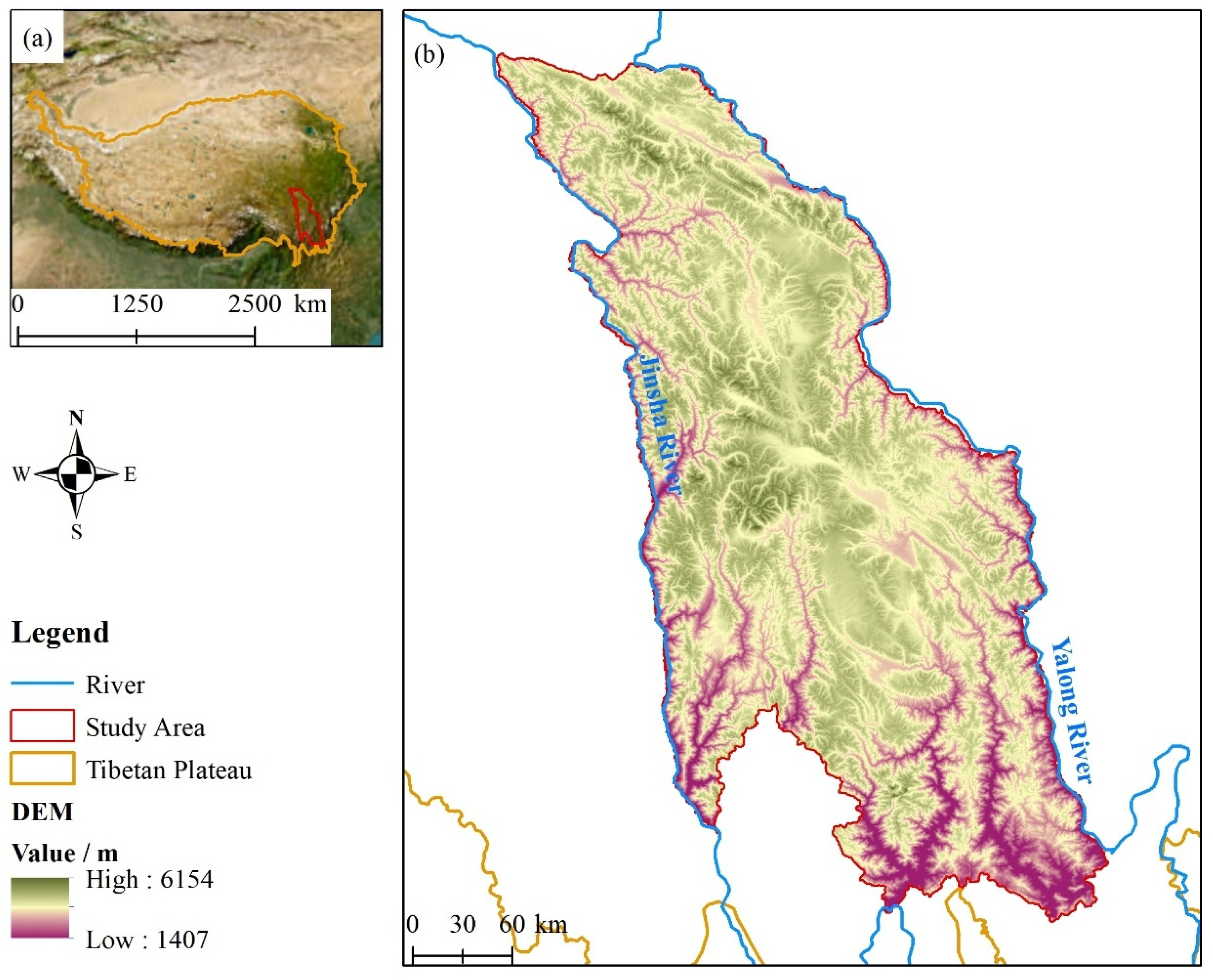
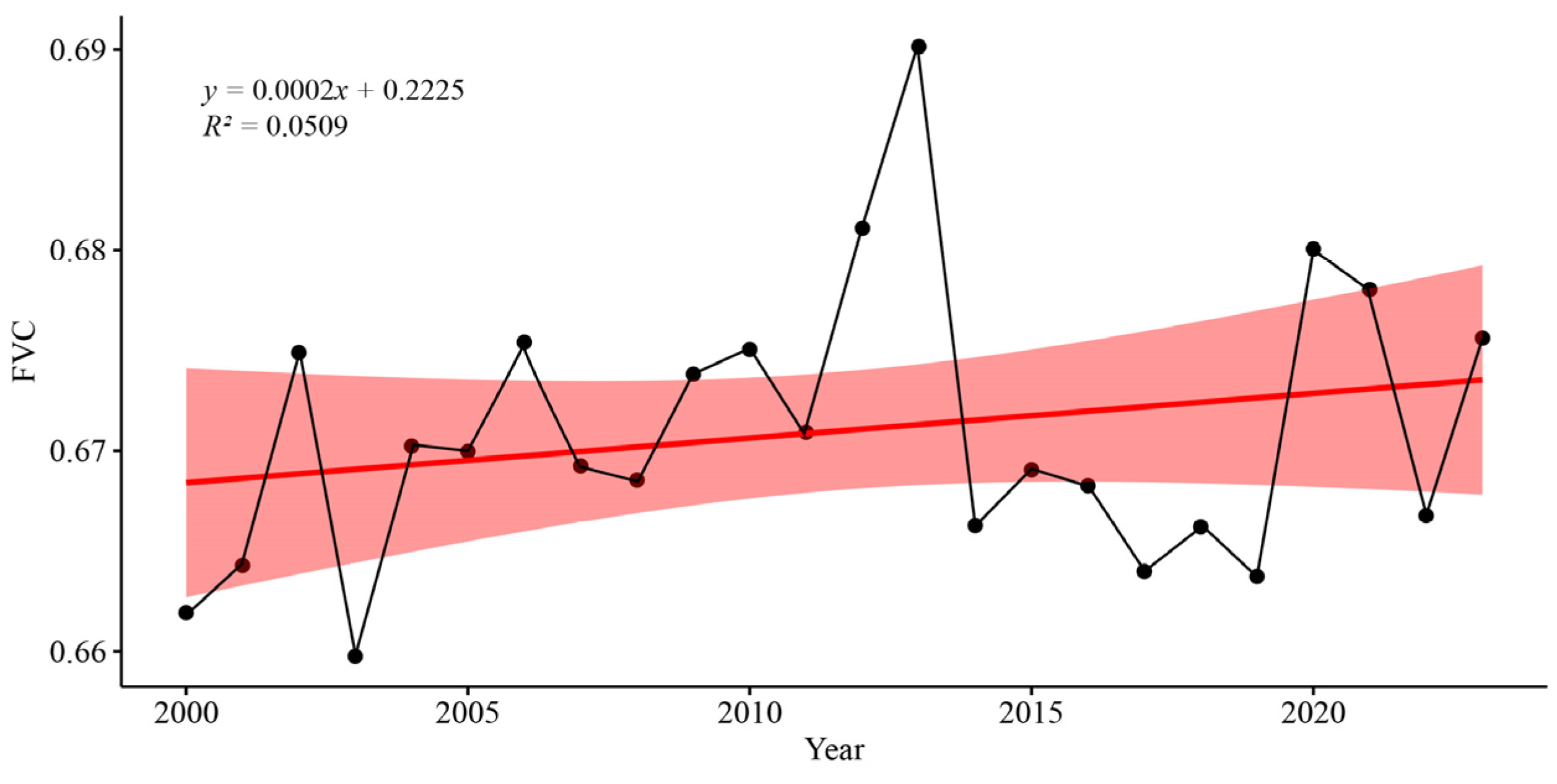
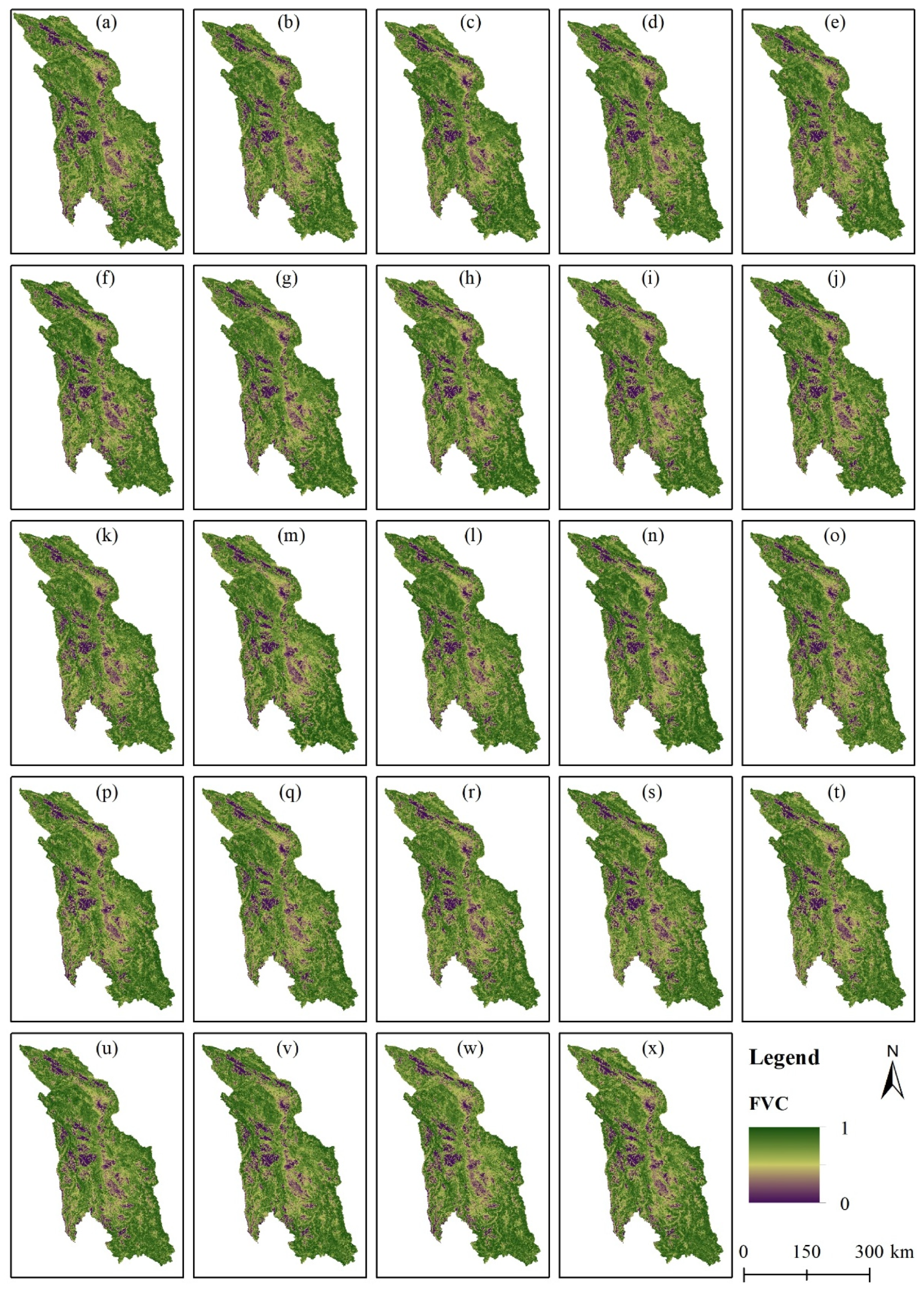



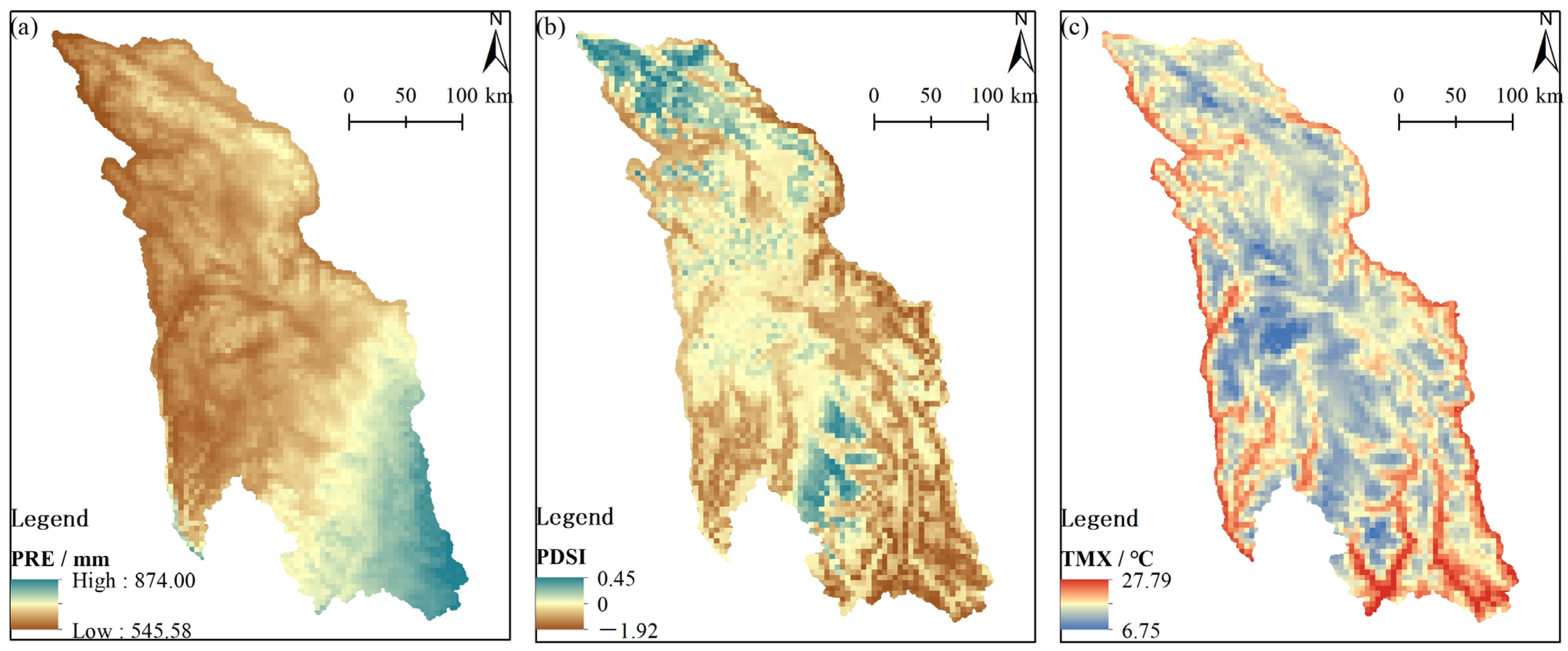



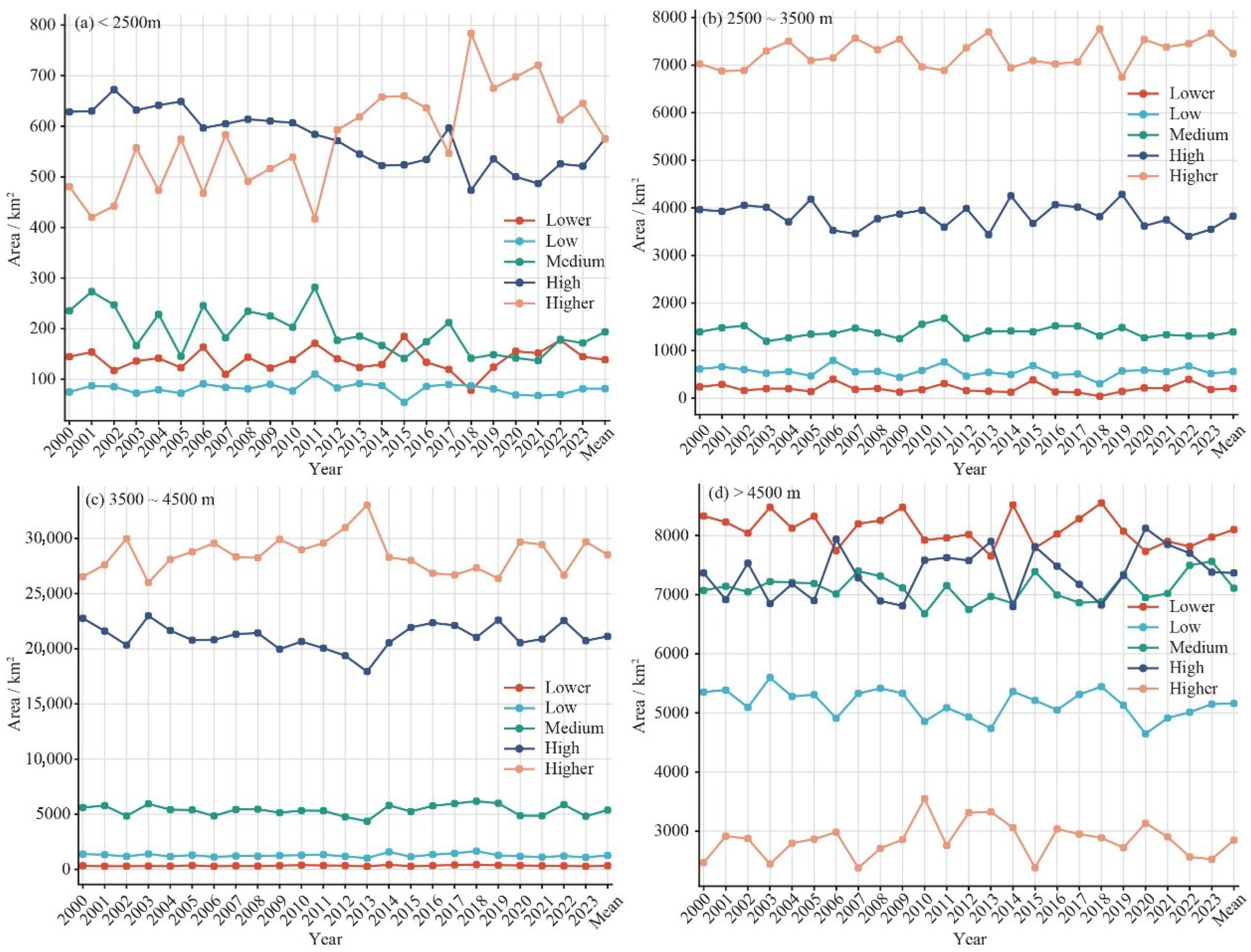
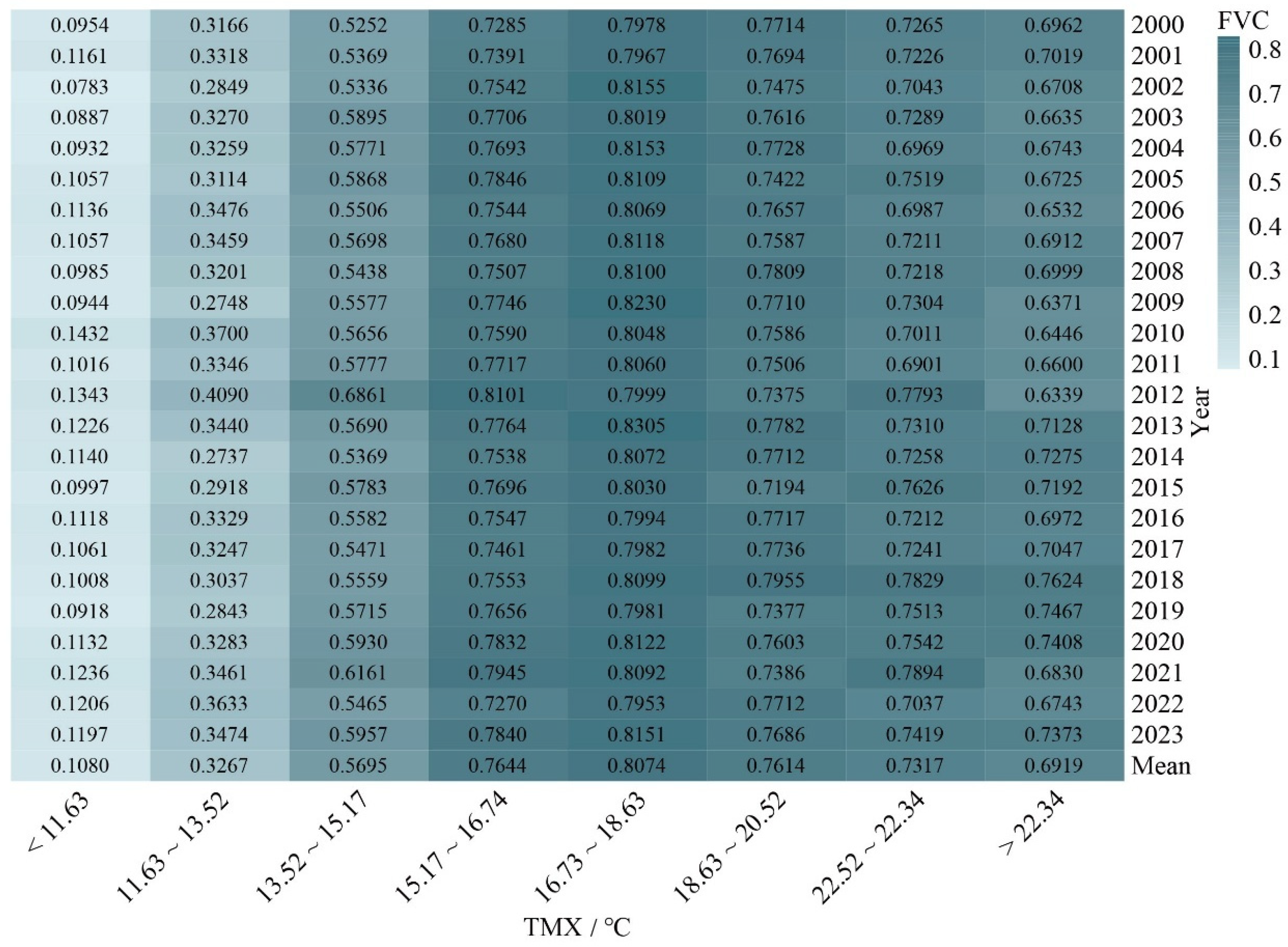
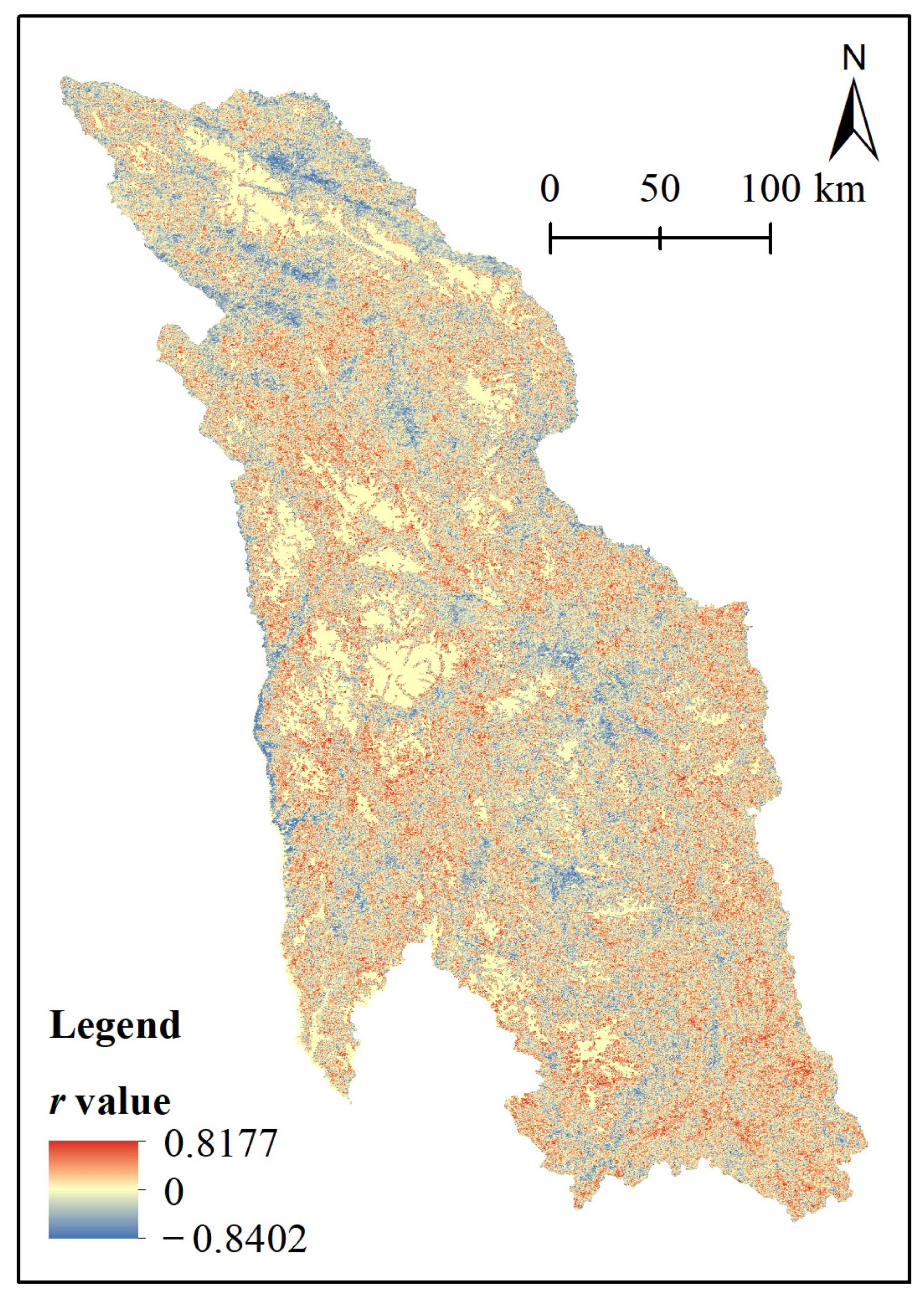
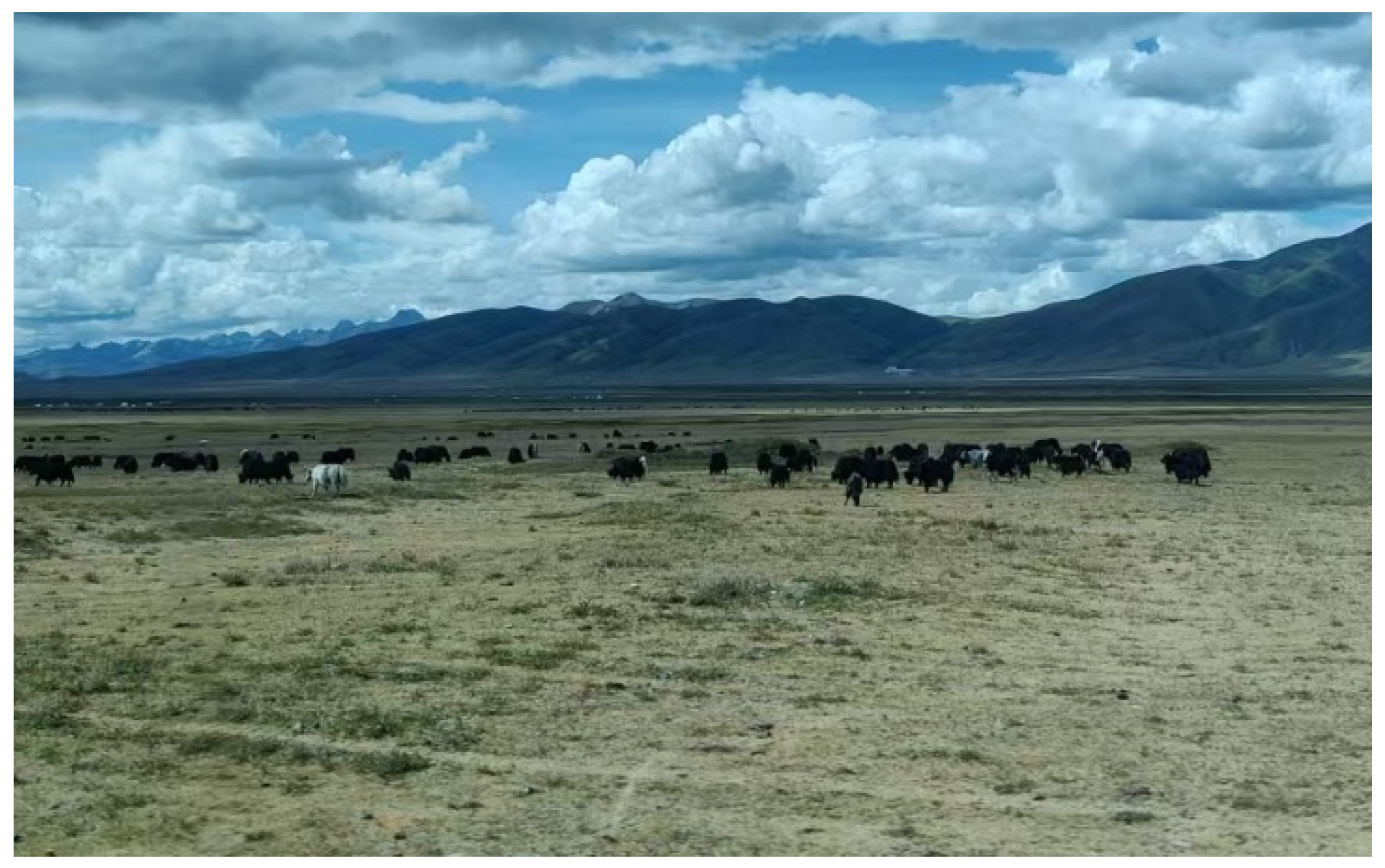
| FVC Value | FVC Class | FVC Value | FVC Class |
|---|---|---|---|
| ≤0.2 | Lower | 0.6~0.8 | High |
| 0.2~0.4 | Low | ≥0.8 | Higher |
| 0.4~0.6 | Medium |
| Categories | SLOPE Value | p Value |
|---|---|---|
| Significant decrease | <−0.0001 | <0.05 |
| Decrease | <−0.0001 | >0.05 |
| Stabilize | −0.0001~+0.0001 | / |
| Increase | >+0.0001 | >0.05 |
| Significant increase | >+0.0001 | <0.05 |
| The Number of People Residing Within Each Grid Cell (Spatial Resolution 92.77 m) (Average from 2000 to 2020) | FVC (Average from 2000 to 2023) |
|---|---|
| 0 | 0.4420 |
| 0–1.38 | 0.6910 |
| 1.38–4.61 | 0.6150 |
| 4.61–10.38 | 0.4353 |
| 10.38–20.06 | 0.3343 |
| 20.06–59.03 | 0.1551 |
Disclaimer/Publisher’s Note: The statements, opinions and data contained in all publications are solely those of the individual author(s) and contributor(s) and not of MDPI and/or the editor(s). MDPI and/or the editor(s) disclaim responsibility for any injury to people or property resulting from any ideas, methods, instructions or products referred to in the content. |
© 2025 by the authors. Licensee MDPI, Basel, Switzerland. This article is an open access article distributed under the terms and conditions of the Creative Commons Attribution (CC BY) license (https://creativecommons.org/licenses/by/4.0/).
Share and Cite
Feng, Y.; Zhu, H.; Zhang, X.; Qin, F.; Ye, P.; Niu, P.; Wang, X.; Shi, S. Altitude and Temperature Drive Spatial and Temporal Changes in Vegetation Cover on the Eastern Tibetan Plateau. Earth 2025, 6, 92. https://doi.org/10.3390/earth6030092
Feng Y, Zhu H, Zhang X, Qin F, Ye P, Niu P, Wang X, Shi S. Altitude and Temperature Drive Spatial and Temporal Changes in Vegetation Cover on the Eastern Tibetan Plateau. Earth. 2025; 6(3):92. https://doi.org/10.3390/earth6030092
Chicago/Turabian StyleFeng, Yu, Hongjin Zhu, Xiaojuan Zhang, Feilong Qin, Peng Ye, Pengtao Niu, Xueman Wang, and Songlin Shi. 2025. "Altitude and Temperature Drive Spatial and Temporal Changes in Vegetation Cover on the Eastern Tibetan Plateau" Earth 6, no. 3: 92. https://doi.org/10.3390/earth6030092
APA StyleFeng, Y., Zhu, H., Zhang, X., Qin, F., Ye, P., Niu, P., Wang, X., & Shi, S. (2025). Altitude and Temperature Drive Spatial and Temporal Changes in Vegetation Cover on the Eastern Tibetan Plateau. Earth, 6(3), 92. https://doi.org/10.3390/earth6030092






